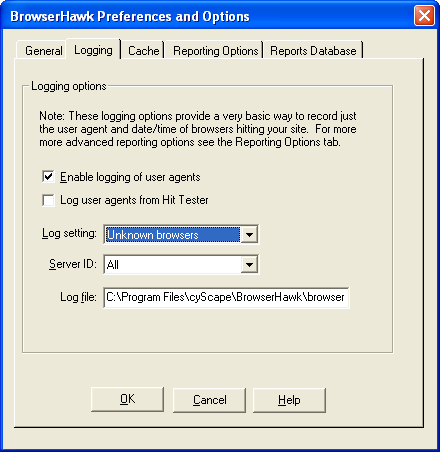
The Logging tab is used to configure how you would like BrowserHawk to handle the logging of user agents which are processed by the BrowserHawk ActiveX component.
Note: Turning on logging can significantly reduce the performance of BrowserHawk, especially on multi-processor machines due to synchronization of the log file write events. This is not likely to cause a significant issue however unless your web site receives very heavy traffic.

Enable logging of user agents:
Check this box if you wish to enable BrowserHawk’s logging feature. Once this box is checked the remaining options on the screen are enabled for you to configure the logging as desired. By default BrowserHawk’s logging feature is disabled
Log user agents from Hit Tester:
Check this box if you wish for BrowserHawk to log user agents tested in the BrowserHawk Editor’s Hit Tester in addition to those user agents processed by the BrowserHawk ActiveX component. By default, user agents tested in the Hit Tester are not logged.
Log setting:
Use this setting to control the type of logging as follows:
None: No user agents are logged. This has the same effect as disabling logging altogether by clearing the Enable logging of user agents box.
Tip: It is more efficient to disable logging then to enable it and set this setting to "None".
Unknown browsers: User agents which do not match any specific browser definitions are considered "unknown" browsers. These browsers are assigned properties set for the Default Browser. Using this option will result in only these unidentified user agents being logged.
All browsers: All user agents, whether matched to a specific browser definition or not, are logged.
Server ID:
This setting is not used currently.
Log file:
Specifies the path and file name that you would like BrowserHawk to use as your log file.
See Also: